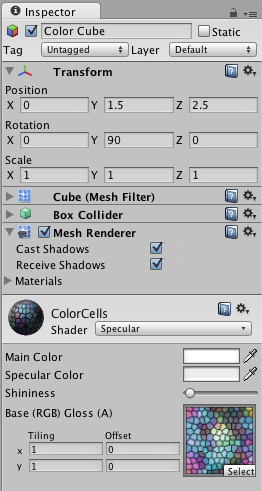Using the Inspector
The Inspector is used to view and edit Properties of many different types.
Games in Unity are made up of multiple GameObjects that contain meshes, scripts, sounds, or other graphical elements like Lights. When you select a GameObject in the Hierarchy or Scene View, the Inspector will show and let you modify the Properties of that GameObject and all the Components and Materials on it. The same will happen if you select a Prefab in the Project View. This way you modify the functionality of GameObjects in your game. You can read more about the GameObject-Component relationship, as it is very important to understand.

Inspector shows the properties of a GameObject and the Components and Materials on it.
When you create a script yourself, which works as a custom Component type, the member variables of that script are also exposed as Properties that can be edited directly in the Inspector when that script component has been added to a GameObject. This way script variables can be changed without modifying the script itself.
Furthermore, the Inspector is used for showing import options of assets such as textures, 3D models, and fonts when selected. Some scene and project-wide settings are also viewed in the Inspector, such as all the Settings Managers.
Any property that is displayed in the Inspector can be directly modified. There are two main types of Properties: Values and References.
Page last updated: 2010-09-13


